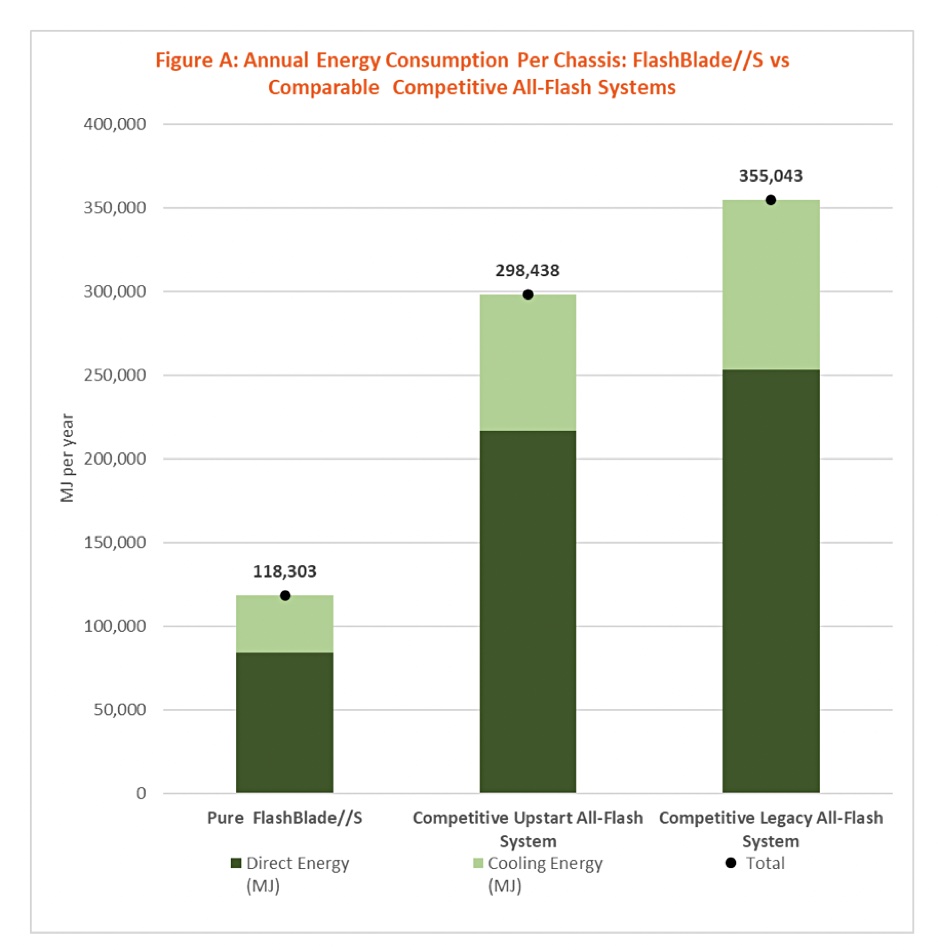Pure Storage says its arrays are more efficient than legacy or upstart all-flash arrays so it has better sustainability credentials.
VAST Data earlier this month claimed its arrays were more efficient than those from Dell and Pure Storage. It said its products were better in terms of electricity usage and e-waste.
Pure Storage’s Biswajit Mishra, Senior Product Marketing Manager for FlashBlade, and FlashBlade Technical Evangelist Justin Emerson say: “Reducing the carbon footprint of storage systems while delivering on business’ digital transformation initiatives, and supporting the fight against climate change and pollution to make the world a better place for everyone are goals we should all get behind.”
Pure says that customers can dramatically reduce their energy use and environmental footprint.
It is providing a Pure1 Sustainability Assessment giving customers visibility of their environmental impact and suggesting optimization actions. The features include:
- Power savings analysis: Pure1 will show the power used compared to the appliance’s nominal power load. Customers can monitor power consumption efficiency for an entire fleet, by data center site, or at the individual array.
- Greenhouse gas emissions monitor: Pure1 provides direct carbon usage estimates based on power used.
- Assessment: Customers can use Pure1 to assess how to improve power efficiency by metering Watts per unit of data on the array that can be read back.
- Recommendations: Pure1 provides proactive insights and guidance on improving direct carbon footprint.
Pure makes a blanket claim that “because of unique design decisions – including Pure’s DirectFlash technology, built-for-flash software, always-on deep compression, and Evergreen architecture – both FlashBlade and FlashArray can achieve energy savings unlike any competitive storage systems on the market.”
Pure Storage has performed use phase sustainability analyses following the application of the third party-audited Life Cycle Assessments (LCA) formula across its portfolio of storage arrays. It says it delivers:
- 84.7 percent in direct energy savings vs. competitive all-flash for FlashArray//X
- 80 percent in direct energy savings vs. competitive all-flash for FlashArray//XL
- 75 percent in direct energy savings vs. competitive hybrid for FlashArray//C
- 67 percent in direct energy savings vs. competitive legacy all-flash for FlashBlade//S
- 60 percent in direct energy savings vs. competitive upstart all-flash for FlashBlade//S
VAST claims a 5.4PB configuration of its Universal Storage consumes 5,530 watts whereas an equivalent 3-chassis FlashBlade//S consumes 8,000 watts.
A Pure blog says FlashBlade//S delivers:
- 67 percent in energy and emission savings vs competitive legacy all-flash systems
- 60 percent in energy and emission savings vs competitive upstart all-flash systems
We can perhaps assume that the legacy all-flash system is Dell’s PowerStore and the upstart one is VAST Data’s Universal Storage. The blog provides a chart of energy consumption per chassis:

It also provides a table showing calculated annual energy savings:

This will give the marketeers at VAST and Dell something to get their teeth into.
Pure says it’s committed to a 3x reduction in direct carbon usage per petabyte by FY30. Read Pure’s inaugural ESG report here.
Comment
We think these sustainability marketing initiatives by suppliers are creditable but could go further. By making claims that don’t furnish direct comparisons with other named vendors and products, such suppliers could be accused of being defensive and striving for marketing advantage rather than helping the storage industry, its customers, and the IT industry generally produce more sustainable products for the good of us all.
As the Pure bloggers say: “Reducing the carbon footprint of storage systems while delivering on business’ digital transformation initiatives, and supporting the fight against climate change and pollution to make the world a better place for everyone are goals we should all get behind.”
The dictionary definition of sustainability is the ability of something to be maintained at a certain rate or level. The concept is used to convey the notion of an avoidance of the depletion of natural resources in order to maintain an ecological or environmental balance. Yet there is no precise definition of environmental sustainability and, therefore, no standard way of measuring it.
The general IT industry use of sustainability centers on combating global warming by reducing greenhouse gas emissions from a process or thing such as a datacenter, server or storage array. For example, a storage array’s electricity use (watts/hour) can be converted into some measure of CO2 emissions.
Blocks & Files thinks there is an opportunity here for an independent research and analysis house to produce named vendor and product sustainability comparisons, using, say, the LCA formula. In other words, we need a transparent industry standard sustainability benchmark.
"pure" - Google News
September 22, 2022 at 06:08PM
https://ift.tt/MBUtXa1
Pure Storage defends sustainability credentials – Blocks and Files - Blocks and Files
"pure" - Google News
https://ift.tt/p72ePCt
https://ift.tt/PwxAIVD
Bagikan Berita Ini














0 Response to "Pure Storage defends sustainability credentials – Blocks and Files - Blocks and Files"
Post a Comment